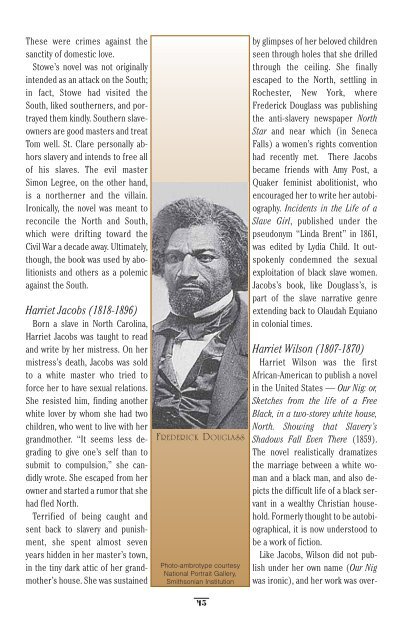outline_us_lit
outline_us_lit
outline_us_lit
Create successful ePaper yourself
Turn your PDF publications into a flip-book with our unique Google optimized e-Paper software.
These were crimes against thesanctity of domestic love.Stowe’s novel was not originallyintended as an attack on the South;in fact, Stowe had visited theSouth, liked southerners, and portrayedthem kindly. Southern slaveownersare good masters and treatTom well. St. Clare personally abhorsslavery and intends to free allof his slaves. The evil masterSimon Legree, on the other hand,is a northerner and the villain.Ironically, the novel was meant toreconcile the North and South,which were drifting toward theCivil War a decade away. Ultimately,though, the book was <strong>us</strong>ed by abo<strong>lit</strong>ionistsand others as a polemicagainst the South.Harriet Jacobs (1818-1896)Born a slave in North Carolina,Harriet Jacobs was taught to readand write by her mistress. On hermistress’s death, Jacobs was soldto a white master who tried toforce her to have sexual relations.She resisted him, finding anotherwhite lover by whom she had twochildren, who went to live with hergrandmother. “It seems less degradingto give one’s self than tosubmit to compulsion,” she candidlywrote. She escaped from herowner and started a rumor that shehad fled North.Terrified of being caught andsent back to slavery and punishment,she spent almost sevenyears hidden in her master’s town,in the tiny dark attic of her grandmother’sho<strong>us</strong>e. She was s<strong>us</strong>tainedFREDERICK DOUGLASSPhoto-ambrotype courtesyNational Portrait Gallery,Smithsonian Institutionby glimpses of her beloved childrenseen through holes that she drilledthrough the ceiling. She finallyescaped to the North, settling inRochester, New York, whereFrederick Douglass was publishingthe anti-slavery newspaper NorthStar and near which (in SenecaFalls) a women’s rights conventionhad recently met. There Jacobsbecame friends with Amy Post, aQuaker feminist abo<strong>lit</strong>ionist, whoencouraged her to write her autobiography.Incidents in the Life of aSlave Girl, published under thepseudonym “Linda Brent” in 1861,was edited by Lydia Child. It outspokenlycondemned the sexualexploitation of black slave women.Jacobs’s book, like Douglass’s, ispart of the slave narrative genreextending back to Olaudah Equianoin colonial times.Harriet Wilson (1807-1870)Harriet Wilson was the firstAfrican-American to publish a novelin the United States — Our Nig: or,Sketches from the life of a FreeBlack, in a two-storey white ho<strong>us</strong>e,North. Showing that Slavery’sShadows Fall Even There (1859).The novel realistically dramatizesthe marriage between a white womanand a black man, and also depictsthe difficult life of a black servantin a wealthy Christian ho<strong>us</strong>ehold.Formerly thought to be autobiographical,it is now understood tobe a work of fiction.Like Jacobs, Wilson did not publishunder her own name (Our Nigwas ironic), and her work was over-45


